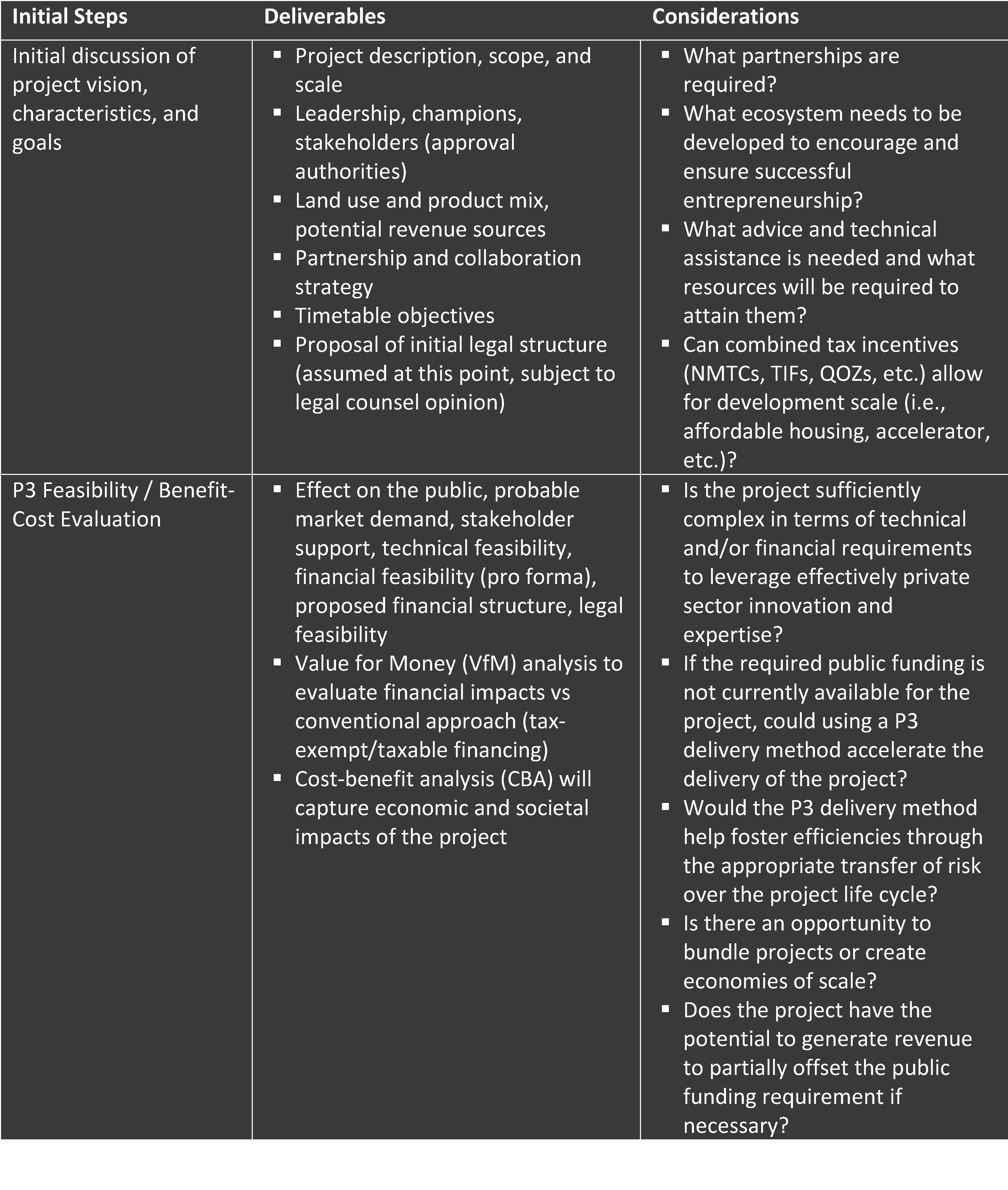Innovation Centers: Physical Infrastructure and Development Through Private - Public Partnerships (P3)
SUMMARY: P3 development financings are common in higher education with many prominent and experienced national development firms demonstrating success. Tax subsidies for eligible projects can attract investor interest and improve financial feasibility.
Author: Kobie Crowder on
Innovation Centers Overview
Good strategy connects policy, initiatives, government, and private spending relative to emerging technology needs, including artificial intelligence, cybersecurity, autonomous vehicles, IoT ("Internet of Things"), and translational research. Focus on key attributes that strengthen partnerships, foster collaboration, increase likelihood of successful technology transfer, and develop strategies for physical space, including development feasibility and pro forma modeling. This approach seeks to maximize the economic impact of innovation strategies throughout a specific locality or region, efficiently convert research to innovation impacts, and help navigate an evolving innovation concept designed to effectively transfer emerging technology to the commercial and Department of Defense sectors. There are generally four specific goals for this business strategy -
- Strengthen technology advancement for the commercial and government sectors in the 21st century.
- Enhance student, alumni, and faculty opportunities and strengthen research and entrepreneurship.
- Strengthen local business investment through collaboration and partnerships with startups, established companies, trade organizations, laboratories, and other key stakeholders.
- Create innovation ecosystems to establish regional geographies as a proven model to attract investors, talent, mentorship, and policies to promote innovation.
Public - Private Partnerships (P3s)
P3s are partnerships with private entities can take many forms, but generally involve a partner that will share the risk of a project, including financing, operations, design and maintenance or some combination thereof. P3s have grown in popularity over recent years, based on a variety of circumstances including lack of traditional funding, maintenance backlogs, federal and state tax incentives, and increased investor interest based on preferred returns. P3s can be applied across many industries with various design considerations, that leverage a partnership between public and private entities that typically use tax incentives to enhance returns and make the project financially feasible, incentives, transfer risk, inspire developer innovation when they have assumed financial risk or are otherwise subject to performance penalties, and reduce costs and total cost of ownership when planned and executed successfully.
The flexibility in design and incentive for investor returns makes P3s an attractive option for physical spaces (i.e., Innovation Centers) to foster open collaboration and cooperation.
Tax Incentives
Public - private partnerships, based on complexity and available tax incentives, can help foster innovation, efficiencies, and greater risk sharing/transfer over the project life cycle.
Investor interest can be strengthened by incorporating eligible tax incentives including Opportunity Zone Funds, New Market Tax Credit, Tax Increment Districts, Low-Income Housing Tax Credits, and other state/local incentives. In the current interest rate environment, P3s generally have a higher total cost of ownership when compared to tax-exempt financing. Therefore, developers look for projects with forecasted returns worthy of investment. This may result in additional revenue that incorporates mixed-use design with office and retail space to offset the higher costs. While risk is typically transferred to the developer, the project has greater risk exposure to micro- and macro-economic conditions that affect vacancy rates and market absorption.
P3 Development Feasibility

The construction industry is poised for contraction considering the COVID-19 pandemic. Additionally, state support for capital projects is likely to be reduced to address additional costs associated with addressing the impacts of COVID-19. However, universities will continue to employ an array of contracting strategies to deliver construction projects successfully. These include traditional Design-Bid-Build, Design-Build, CMAR (Construction Manager at Risk), IPD (Integrated Project Delivery) and privatized development (public-private partnerships).
Over the last thirty years, universities have largely increased privatized projects planned, in progress, or completed, and continue to explore the use of this project delivery option as opportunities permit. Additional strategies to enhance project delivery include Building Information Modeling (BIM); Best Value selection (for contractors and/or subcontractors) and utilizing Design-Assistor Design-Build on specific trade packages within another overall delivery format.
Whatever solutions colleges and universities employ to address these challenges, leaders should remain flexible and continuously reevaluate their universities’ situations in what is bound to be a highly uncertain future
The measures or indicators used to assess the general condition of university capital programs are project budget changes and project schedule changes. It should be recognized that institutional ability to implement its capital program is affected by several factors, only some of which are within the control of the campus. Those within campus control include project delivery methods, program changes, and budgeting and funding strategies. Factors beyond campus control include the construction industry bid climate, local and global market conditions, regulatory changes, State and non-State funding requirements, available tax incentives, and unforeseen physical and environmental conditions.
It should also be recognized that some project budget and schedule changes are driven by circumstances that are intentional, necessary, and beneficial to the campus mission—such as incorporating program improvements, multiple project phasing, and leveraging of new funding opportunities.
Because many variables affect project delivery, simple indicators do not fully represent the complexity of factors that influence campus capital project implementation. Nevertheless, these key indicators of budget and schedule provide valuable insights into program trends and can highlight where anticipatory or remedial action may be required.
Speculative New Ventures
Innovation and new ideas will clearly be at a premium in the years ahead. If strategic and facilities planning are not well-integrated, however, ideas can jump the track to design and construction without being fully tested against other options and embedded in a rigorous business plan. Using policies and practices that scrutinize a project’s validity will help enforce discipline and keep speculative ideas from diverting resources from established commitments.
Summary
P3 development financings are common in higher education with many prominent and experienced national development firms demonstrating success. In addition, tax subsidies for eligible projects can attract investor interest and improve financial feasibility.
Copyright © 2021, Crowder Strategies, LLC. All Rights Reserved.